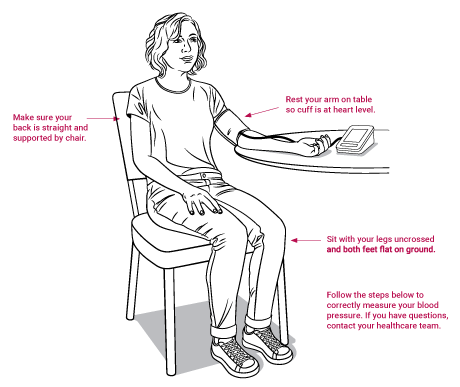When you have heart failure, it is very important to monitor your weight, blood pressure and heart rate every day. Follow these tips to help you accurately measure these three items and record them on your daily log sheet.
Watch for Weight Gain
When you have a diagnosis of heart failure, it is important to closely monitor your weight. A sudden increase in your weight may indicate that your heart failure is getting worse and that fluid is building up in your body. Weighing yourself daily can help you and your healthcare team better manage your heart failure.
How to track your weight:
- Weigh yourself with the same scale, every day around the same time.
- Weigh yourself in the morning, after you go to the bathroom and
before eating breakfast. - Wear the same amount of clothing each time you weigh yourself. Don’t wear shoes.
- Record your weight on a daily tracking worksheet or calendar. Bring your weight records to your clinician appointment.
- If you gain weight suddenly (more than 2-3 pounds in one day or more than 5 pounds in 1 week), call your clinician.
Monitor Your Heart Rate
Your heart rate is measured by counting the number of times your heart beats in one minute. Your heart rate is lower at rest and higher when you are active or exercise. Use your blood pressure or heart rate monitor to track your heart rate daily.
Monitor Your Blood Pressure
When you have heart failure, your blood pressure can be low or high. If you have high blood pressure, lowering it will decrease the amount of work your heart must do and keep you healthier. Low blood pressure can make you feel dizzy or tired. For these reasons, it is important to monitor your blood pressure accurately. Talk to your clinician about how blood pressure affects your heart failure. See below for step-by-step instructions on how to choose a blood pressure monitor and properly take your blood pressure.

Choose a Home Blood Pressure Monitor
Buy a monitor with an arm cuff. Most pharmacies sell automatic blood pressure monitors, such as Omron®, A&D and Microlife.® Don’t buy a monitor with a wrist or finger cuff, which are not as accurate. Ask the pharmacist if you have questions.
Make sure the arm cuff fits. Before you buy a blood pressure monitor, measure your arm so you can be sure the cuff will fit. Use a string or measuring tape to measure around the circumference (largest part) of your upper arm, halfway between your elbow and shoulder. Most blood pressure monitors will list the arm circumference range on the box. Select the right size based on your arm measurement.
Make sure your monitor works correctly. Bring it in to your healthcare team when you first buy it and then once a year afterward. In addition, bring your monitor to get checked if your home measurements are regularly 10 mmHg different (higher or lower) than those at your healthcare visits.
Measure Your Blood Pressure Correctly
- Take it at the same place and time(s). Good times to measure are in the morning before taking medications and in the evening before dinner.
- Don’t drink caffeine (such as coffee), exercise or smoke for at least 30 minutes before taking your blood pressure.
- Use the restroom and empty your bladder before
sitting down. - Sit comfortably with both feet flat on the floor for five minutes before taking your blood pressure. Sit with your back straight and supported (on a dining chair,
for example, instead of a sofa). - Rest your arm on a table so the blood pressure cuff is about the same height as your heart (the middle of your chest). Unless otherwise directed, you may use either arm, but use the same arm each time.
- Wrap the cuff around your bare upper arm (not over clothing). Place the bottom of the cuff directly above
the bend of the elbow. - Don’t talk or do other activities while measuring your blood pressure.
- Keep a log of all your measurements.
More Resources
Healthwise Resource Library
Look up helpful health information.
Patient Information
Practical info for Sutter patients.
Tools and Quizzes
Online tools to help you make decisions about your health.









